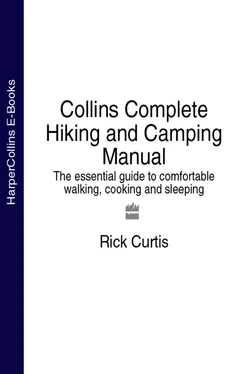Global Positioning System (GPS) Receivers GPS receivers use satellites to identify your exact position. They can be a great help in planning your route, keeping track of your location, and navigating from place to place. Even so, a GPS is not a replacement for knowing how to use a map and compass. For more on GPS, see page.
Personal Radios Personal radios using the FRS or GMRS have become increasingly popular when hiking. They can be helpful for larger groups who split up. FRS radios have a range of about 1/2 mile (0.8 kilometer), while GMRS have ranges up to 5 miles (8 kilometers).
Personal Locater Beacons (PLBs) Personal Locator Beacons are another satellite technology. This is a land-based version of rescue beacons that have been in use by mariners for some time. When activated the beacon sends an emergency signal to a satellite along with your exact position. This is not a phone, so all the signal means is “I have an emergency.” All PLBs must be registered so the responding agency knows who initiated the call (in part to discourage false activations). If a signal is received, the Rescue Coordination Center telephones the beacon’s owner and/or emergency contact to check to see if the beacon going off is a false alarm. If it cannot be determined that the signal is a false alert, SAR teams are dispatched to locate the person in distress. Pushing the button means mobilizing a potentially huge rescue effort, so it had better be a real emergency. There are certainly real uses for these devices, particularly for people who travel in remote parts of the world.
The ongoing debate about the use of these types of technology when hiking is that carrying these devices creates a false sense of security, the “Hey, if something goes wrong we just use the Satellite Phone, PLB, GPS, etc.” approach. Some people are justifiably concerned that people may go into wilderness areas without sufficient experience because they assume they can always get rescued, or don’t take a map because they have a GPS receiver. What’s important to remember is that these are just tools and have limitations. They get left in camp, batteries die, somebody steps on the thing or drops it off a cliff. If you don’t have it or it doesn’t work, you’d better have the skills to handle the situation. These devices should be used as an adjunct for emergency assistance or navigation, not as a replacement for sound training and good judgment.
CHAPTER 3
Cooking and Nutrition
ENERGY AND NUTRITIONAL REQUIREMENTS
Caloric Requirements
Food Sources
BASIC FLUID RECOMMENDATIONS
MENU PLANNING
How Long are You Going to be Out?
Ease of Preparation
Weight
Packaging/Repackaging
Spoilage
Eating on the Trail
GENERAL COOKING GUIDELINES, INGREDIENTS, AND RECIPES
Sample Recipes
OUTDOOR BAKING
FOOD EQUIVALENTS
MEASUREMENT EQUIVALENTS
Food can be one of the most important and complicated elements to plan for a trip. You have to be aware of nutritional requirements, individual dietary needs, and amounts required to feed the entire group. Plus, the food should be appetizing—there is nothing better than a delicious hot meal to bolster morale after a long, hard day of hiking, and nothing worse than trying to keep up your strength while staring into a cup of disgusting mush. Seasoned through-hikers may be more concerned with weight than taste or variety, but it can be difficult to get people, particularly inexperienced backpackers, to eat a meal that doesn’t taste good.
ENERGY AND NUTRITIONAL REQUIREMENTS
Good nutrition is just as important, if not more so, in the outdoors as it is at home. Food supplies energy to your body to fuel your physical activity and keep you warm. Food also provides essential nutrients that your body cannot produce: vitamins, minerals, certain amino acids, and certain fatty acids. The amount of energy the body takes in from food is measured in units of heat energy called calories. When planning a menu for a trip, it is important that the foods be high in calories in order to meet these requirements.
CALORIC REQUIREMENTS
Below are the general ranges for calories required to maintain good health, and what you will typically need to carry. Keep in mind that the food weights are averages, since carrying only dehydrated foods, for example, would mean carrying less weight. Also, at higher altitudes the caloric requirements per day increase.
| Activity |
Caloric Requirement/day |
Food Weight/day |
| Your body’s basal metabolism |
1,500–2,000 |
|
| Three-season backpacking or normal exercise output |
2,500–3,000 |
1.75–2 pounds (0.8–0.9 kilograms) |
| Cold-weather backpacking or strenuous exercise output |
3,500–4,000 |
2–2.25 pounds (0.9–1 kilograms) |
| Winter backpacking or very strenuous exercise output |
4,500–6,000 |
+2.5 pounds (+1.1 kilograms) |
FOOD SOURCES
Carbohydrates(4 calories/gram, energy released quickly) regularly make up about 50 percent of a person’s daily caloric intake. For hiking trips you may need to increase this to 70 percent of the daily caloric intake. Starches and sugars provide both quick energy and longer-term fuel. Processing and refining can reduce the nutritional value of carbohydrates, so it is best to use whole grains, raw sugar, and other unprocessed foods in your menu. Simple carbohydrates (sugars such as trail snacks or sweets) are broken down very quickly by the body for quick energy release, and complex carbohydrates (such as pasta) release energy more slowly.
Fats(9 calories/gram, energy released slowly) are another important source of energy when hiking. It is recommended that about 25 percent of your daily intake be fats (during the winter this should increase to about 40 percent). Fats take longer to break down than carbohydrates and thus are a better source of long-term energy. For example, adding a spoonful of butter or margarine to a cup of hot chocolate will increase the caloric rating and the length of time the energy is released.
Proteins(4 calories/gram, energy released slowly) are an essential part of any diet. Proteins are the essential building blocks of all tissue. Each protein in the body is made up of twenty-two amino acids. Fourteen of these amino acids are produced in the body, and the other eight, known as the “essential amino acids,” are not. Both types are essential to a complete diet. Foods such as meat, poultry, fish, eggs, and milk products are called “complete proteins” since they contain all eight essential amino acids. However, there are limitations to carrying fresh meats, poultry, and eggs due to weight or spoilage. Canned or vacuum-sealed pouches of fish or precooked chicken can be carried. Soybeans and soy products are also complete proteins.
Foods such as beans, lentils, peanuts, cereals, vegetables, and fruit are incomplete proteins since each of them doesn’t contain all eight amino acids. However, by using proper combinations, an outdoors menu can be planned that allows you to get all eight amino acids daily. An easy way to remember this is using the “Nutritional N ” to create food combinations. The N contains four elements: dairy, grains, legumes, and seeds. Any two adjacent food groups in the N , when combined, provide complete protein.
Dairy Cheese, milk, yogurt
Grains Breads, crackers, pasta, granola and other cereals, rice, couscous, bulgur, bran, potatoes, corn, oats
Legumes Beans, peas, lentils, peanuts, tofu
Seeds Sunflower, sesame
The phrase “ Don’t Get Love Sick” ( Dairy, Grains, Legumes, Seeds) may help you remember the four groups and the order in which they form the nutritional N. Just string the four elements together in alphabetical order. A combination of any two consecutive initial letters of the phrase will provide complete proteins. Dairy and Grains (D & G), for instance, will form a complete protein together, whereas dairy and legumes will not. The other two complete protein combinations are Grains and Legumes (G & L) or Legumes and Seeds (L & S).
Читать дальше












